When you have visited all the main sites and been through the popular things to do in Rome, it’s time to look beyond the Colosseum and the trevi Fountain.
You might have time to spare on your Rome itinerary or you might visit the city for the second, third, or fifth time and you want to see something new. Rome off the beaten path, something you don’t find in the guidebooks.
If this sounds like you, I’ve got you covered. Since my family is from Rome, I’ve spent a whole lot of time there my entire life and have always loved discovering the secret Rome.
In this post, I’ve put together some of my absolute favorite places and hidden gems in Rome so that you can explore the city beyond the major tourist traps.
Get ready to discover amazing places you would never believe don’t get more attention!
Disclosure: This post may contain affiliate links. That means that if you make a purchase through one of those links, I will get a small commission at no extra cost to you.
Rome off the beaten path places
Pyramid of Caius Cestius
One of the most unusual things to do in Rome might just be this. Visiting a pyramid. Rome has a lot of reminders of Egypt with as many as thirteen obelisks dotted around the city. But not many tourists know that there’s an actual pyramid there too.
Funny enough, the pyramid has its own metro stop too – Piramide. The Pyramid of Caius Cestius is situated right by Porta San Paolo.
It was built as Caius Cestius’ tomb between the years 18 and 12 BC during strong Egyptian influence and a time when the Roman kingdom was obsessed with everything Egyptian and was one of two pyramids. The other pyramid didn’t survive.
At the time the tomb was built, it was even more off the beaten path in Rome as burial sites weren’t allowed within the city walls and it stood in the open countryside.
In 2016, the 36-meter tall pyramid opened for the public, but it’s only possible to visit on the 3rd and 4th Saturday and Sunday of the month and can only be pre-booked at the official website.
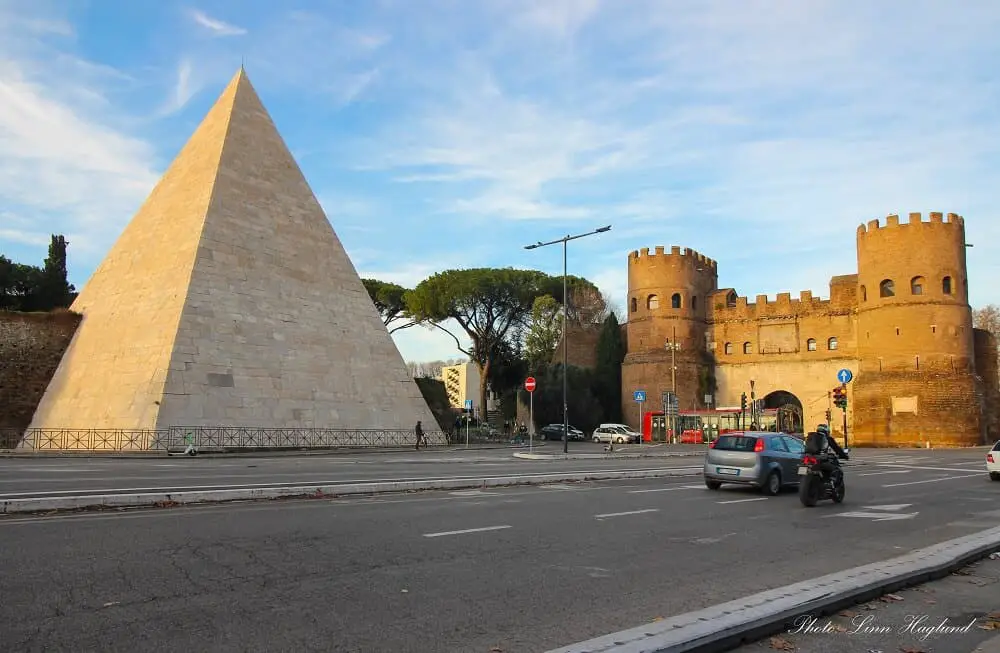
Giardino Degli Aranci
One of the best viewpoints in Rome is the quaint Giardino Degli Aranci. The garden used to be one of the secret places in Rome, but with the years and the rising popularity of the Buco della Serratura dell’Ordine di Malta a little further up the road, it’s seeing more traction.
This is still considered “hidden Rome” since most tourists don’t have the time to venture up there when only spending a few days in the city.
The orange garden is nice for a short stroll and the views are absolutely worth the trip. Especially, because there are a lot of other great places to discover in the same area.
Giardino Degli Aranci is situated a short walk from Circo Massimo on Aventine Hill.

Basilica di Santa Sabina all’Aventino
Italy, especially Rome, is jam-packed with basilicas and opposed to other countries, they’re all incredible inside. Basilica di Santa Sabina all’Aventino is one of my absolute favorites. Maybe because I love ancient-looking structures that are simple, yet leave you in awe.
Founded in 425 by a Dalmatian priest, the church was built on top of an ancient Titulus Sabinae. But throughout the years, new parts have been added, and in the early 20th century it was completely restored leaving it with a medieval look.
The inside is astounding with large columns leading up to the altar and colorful frescos. In the back of the church, the large wooden doors have astounding carvings worth a look.
The basilica is situated right outside Giardino Degli Aranci on Aventine Hill and can be entered for free.

Giardino di Sant’ Alessio
Not far from Giardino Degli Aranci, you find a lesser-visited garden that I personally like a lot more, Giardino di Sant’ Alessio.
The views of the city aren’t as good as from Giardino Degli Aranci (mainly because there are more trees in the way,) but the slightly smaller garden is so much nicer.
It’s situated right outside the walls of Basilica dei Santi Bonifacio e Alessio with its magnificent bell tower which gives shade to the garden.
Make sure you don’t miss the small, but beautifully detailed fountain by the wall, with a dove spitting out water.

Basilica dei Santi Bonifacio e Alessio
Another of the hidden gems Rome hides on Aventine Hill is the Basilica dei Santi Bonifacio e Alessio. First named after the martyr, St. Boniface, and later also named after St. Alessio.
According to legend, the latter had escaped an arranged marriage. When he came back many years later, he was not welcomed by his family and had to live the rest of his days in the house’s basement as a beggar.
You can still see the stairs that supposedly lead down to the place where St. Alessio lived to his day’s end, though the basilica has been renovated numerous times since then.
The Romanesque bell tower is stunning and so are the views of St. Peter’s Basilica that you get from the cloister.
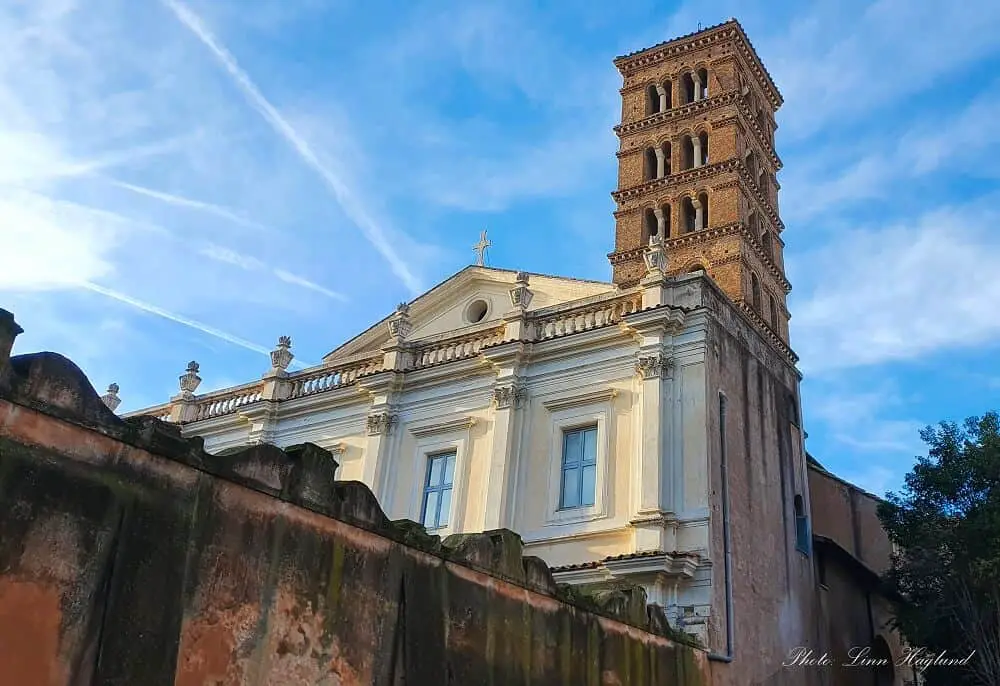
Buco della Serratura dell’Ordine di Malta
When I was a kid, the Buco della Serratura dell’Ordine di Malta was considered the hidden Rome. Though throughout the years, the secret is spilled, this is still a lesser-visited place in Rome that only those that have enough time in the city take the time to discover.
The tiny Keyhole of the Knights of Malta (yes, it’s an actual keyhole) is found on the green door on the top of Aventine Hill. Have a peek inside and you’ll be surprised with the most unique view in Rome.
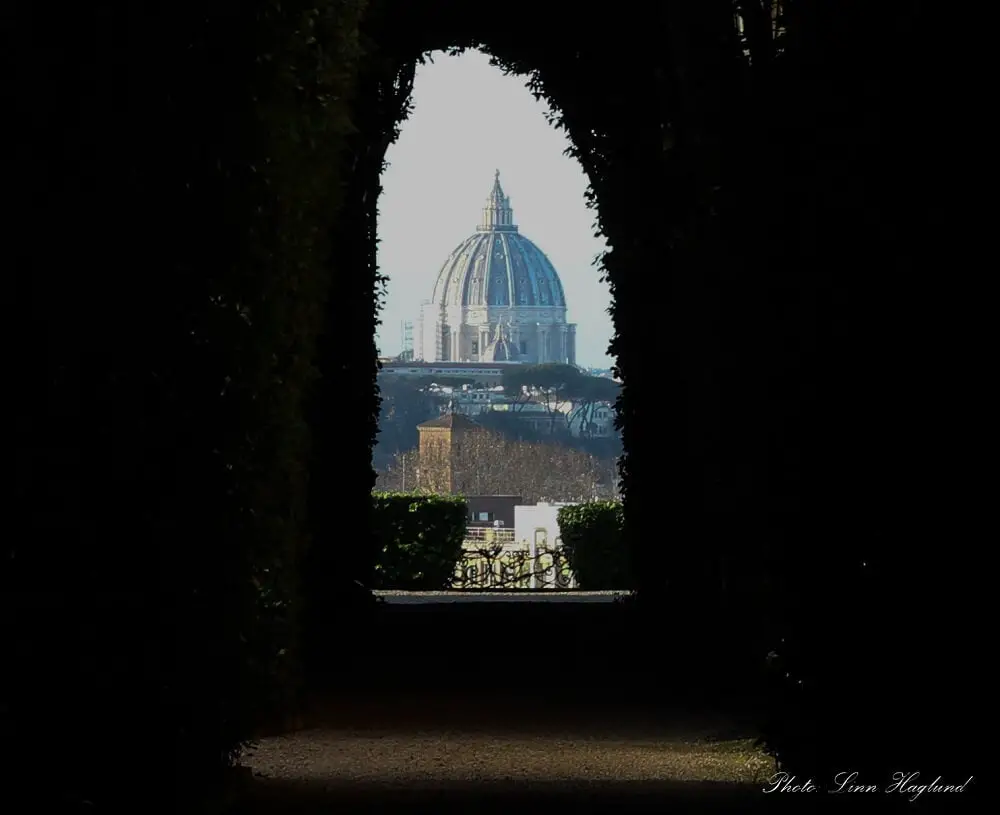
Through the perfectly lined trees on the other side of the door, you get the view of the perfectly framed St. Peter’s Basilica dome. It might be hard to get a perfect picture, but this is a view that will stay with you forever.
If you travel to Rome in winter, there’s a big chance that most of those in the queue to get a glimpse through the magic keyhole are Italians. However, no matter when you go in the year, it’s a good idea to get there fairly early to avoid the crowds.
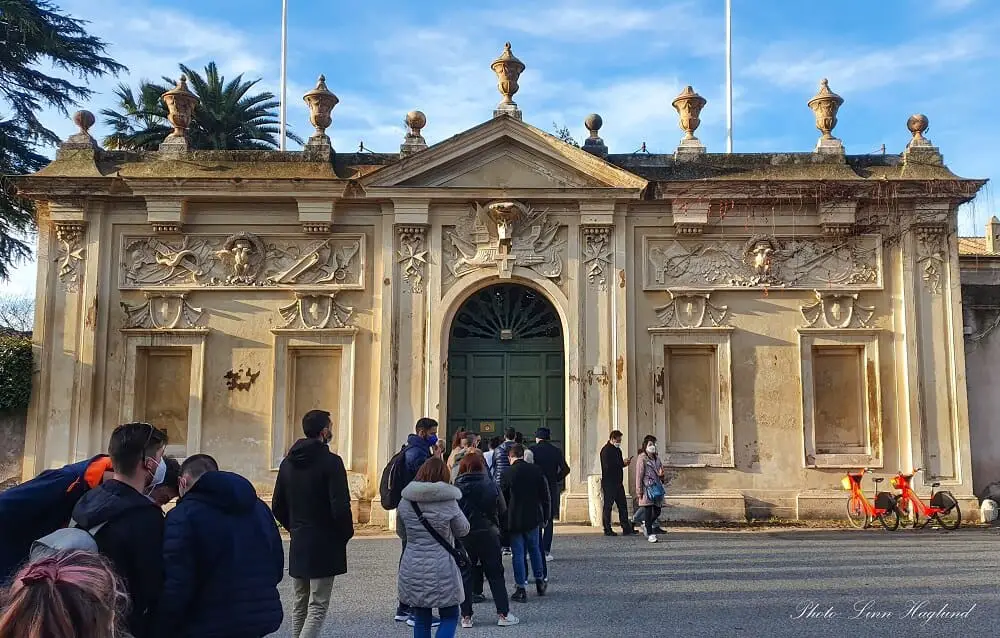
Basilica of San Pietro in Vincoli
The Basilica of San Pietro in Vincoli is one of the many interesting churches you should venture into. For being Rome, it’s quite modest on the outside.
But once you enter, you’ll be met by large, white columns leading to the beautifully decorated altar. The ceiling is covered in detailed frescoes.
Nonetheless, the main attraction of the Basilica of San Pietro in Vincoli is the tomb of Pope Julius II. The tomb is decorated with Michael Angelo’s famous statue of Moses.
However, this isn’t the most unique part of the basilica. Legend says that the chains that had been used on St. Peter in Jerusalem had been brought back to Valentinian III’s wife, Licinia Eudossia.
She gifted them to Pope Leo the Great because he already had the chains used in the Mamertine Prison. But when the two chains were brought together, a miracle happened and the two chains became one.
Licinia Eudossia built the Basilica of San Pietro in Vincoli (meaning the Basilica of St. Peter in Chains) and up to this date, the chains are kept beneath the high altar and can be seen by the public every 1st of August.

Domus Aurea
I’m adding the Domus Aurea to this list of off the beaten track Rome attractions because it’s a huge site that deserves more attention.
The site has been opened and closed and opened again for the public several times due to restoration work. Thus it doesn’t appear on most people’s itineraries when visiting Rome. And it should be.
You probably wouldn’t believe that it’s just across the street from the Colosseum, but most tourists venture straight to the Roman Forum, which is in the opposite direction.
The Domus Aurea was built by Nero after the big fire in 64 AD. His plan was to turn Rome into this new city, Neropolis.
Today, there is a cat sanctuary there and you can see the remains of what might have been the most excessive building ever built during the Roman Empire with 300 rooms.
Domus Aurea is also known as the Golden House due to the enormous golden dome that was built.
The remains of Domus Aurea are only open three days a week. It’s mandatory with guided tours which are available every week from Friday to Sunday and has to be booked in advance.
You can book your ticket here.

Basilica di San Giovanni in Laterano
One of the most underrated sites in Rome off the beaten path is the Basilica di San Giovanni in Laterano, one of the city’s 4 stunning Papal basilicas.
This is the oldest church in Rome, founded in 313 when emperor Constantine the Great allowed freedom of religion. It then served as a Papal residence. Since then, it’s been destroyed in the earthquake of 896 and several major fires after that.
Today’s facade with its Alessandro Galilei statues dates back to the 18th century. Enter the basilica and you’ll be enraptured by the amazing work of Bernini’s students – 12 statues of the apostles. The ceiling is covered in Michelangelo’s student’s frescos, designed by the master himself.
Make sure you take time to visit the sublime Lateran Palace which served as the Pope’s residence for about 1000 years before it was moved to the Vatican.
Across the basilica, you can see the Scala Sancta, Holy Steps, which are said to have been brought from Pontius Pilate in Jerusalem. Apparently, Jesus himself walked on these steps.
Behind the Basilica di San Giovanni in Laterano, on the Piazza di San Giovanni in Laterano, you can maze up at the tallest and most ancient Egyptian obelisk in Rome.
You can book a guided tour of the Lateran Palace here.

Chiesa San Stefano Rotondo al Celio
One of the best hidden gems Rome conceals is the Chiesa di San Stefano Rotondo al Celio. The church dates back to the 5th century and is the oldest circular church in Rome.
Around the corner from Villa Celimontana, you have to look for a gate in the surrounding Roman walls with the name of the church handwritten above the entrance.
The interior of the church is noteworthy with 22 marble columns making a circle around the centered altarpiece. on the walls outside the columns, there are 34 frescos showcasing the Cycle of Martyrdom.

Vittorio Emanuele II Square
A stroll through Vittorio Emanuele II Square, in the multiethnic Esquilino district, is truly one of the most pleasant non-touristy things to do in Rome. This is where local families and kids gather to play ball or go skateboarding.
Sit down at a bench and soak in the surroundings, the people, the sculptures, the trees… Or go for a walk and enjoy the interesting artwork across the square.
Vittorio Emanuele II Square is truly a place to slow down, something that’s well-needed after a day of sightseeing in Rome.
The square was built in 1870 to commemorate Italy’s first king. The main attractions on the square are the 3rd-century Roman Fountain and the Porta Magica (Magic Door) also known as the Porta Alchemica (Alchemic Door.)
The door was built by Massimiliano Palombara Marquis of Pietraforte between 1655 and 1680 for his residence, Villa Palombara. Today, the monument is the only part remaining of the villa.

Capuchin Crypt: The bone chapel
The bone chapel is one of the most chilling hidden gems of Rome. I’ve been to a few bone chapels, but this is seriously one of the most unique I’ve seen.
Beneath the Santa Maria della Concezione dei Cappuccini, you’ll find a series of chapels elegantly decorated with human bones. The ceiling and walls are a canvas for an art that truly isn’t for everyone.
Using the bones of thousands of Capuchin friars to create an incredible artwork – even the chandeliers are made of human bones – the Capuchin order wanted it to be a reminder of human mortality.
It’s not allowed to take photographs inside, so you’ll have to go discover it by yourself. I promise you it’s worth it.
Besides the church, you can visit the Capuchin Museum which is dedicated to the history of the Capuchin order.

WHERE ARE YOU HEADED NEXT
- Things to do in Orvieto
- Towns on the Amalfi Coast
- Amalfi coast itinerary
- Things to do in Porto Venere
Basilica San Silvestro in Capite
When you enter the courtyard of Basilica San Silvestro in Capite, you really feel like you’ve found one of the most incredible secret places in Rome. The walls are decorated with ancient inscriptions and artwork which makes it feel like a museum.
Enter the church itself, and you’ll be mesmerized by a beautifully adorned interior in gold and marble and wonderful sculptures.
The basilica was ordered by the Popes Stephen III and Paul I. They’re both buried beneath the church. It served as a shrine to the martyrs and Christian saints that were buried in the Catacombs and their relics were placed in the church.
But most famously, you can see a fragment of Saint John the Baptist’s skull in the basilica.

Villa Celimontana
When venturing off the beaten track in Rome, I highly recommend taking a detour to Villa Celimontana. Sitting on the Caelian Hill, it boasts a splendid garden with enchanting paths winding through old trees, sculptures, and Roman remains.
There’s even an Egyptian obelisk in the garden. If you venture a little further, you get to a wonderful viewpoint with sweeping city views.
The villa, known as Villa Mattei, was built in 1580. At one time it was used to offer accommodation to pilgrims walking the route of the Sette Chiese di Roma (Seven Churches of Rome.)
When Emperor Nero extended the Aqua Claudia aqueduct to the Caelian Hill to get water to his own villa, it became a lush and exclusive part of Rome that once was covered in vines.

Basilica di San Clemente
If you’re looking for secret things to do in Rome, take a peek into the history of Basilica di San Clemente.
Just a stone’s throw away from the Colosseum, this small 12th-century basilica is built on top of a church from the 4th century, making it one of the oldest churches in Rome.
But excavations reveal remnants from the 1st century and seemingly even older ones.
Visiting the church, you can see different layers of history through excavated mosaics, frescos, and structures from the ancient church.
If Basilica di San Clemente was situated in any other city without so many grand attractions to compete with, it would be a major tourist attraction!

Galleria Sciarra
Tucked away a few steps from the crowded Trevi Fountain, you find one of the most pleasant hidden gems of Rome, the Galleria Sciarra.
Step into the opulent courtyard of Galleria Sciarra and get astonished by the colorful Art Noveau scene that meets your eye.
Colorful frescos painted by Giuseppe Cellini, meant to celebrate women of all ages and phases in life, cover every inch of the 4 story walls. Perfectly lit up by sunlight from the glass ceiling giving natural light to the unique artwork.
Originally, the courtyard was built in the 19th century for the wealthy Sciarra Family. Originally it was meant to be a shopping mall – even so, it would have been a shopping mall worth visiting just for the wall decorations!

Basilica of the Holy Cross in Jerusalem
One of the many hidden gems in Rome is the Basilica of the Holy Cross in Jerusalem, which was part of the ancient pilgrimage route of the Seven Churches in Rome.
Around the year 325 the church was blessed with Passion Relics that St. Helena of Constantinople (Emperor Constantine I’s mother) brought to Rome from the Holy Land.
It’s said that the church floor was covered in soil from Jerusalem, thus the name; Basilica of the Holy Cross in Jerusalem.
Situated a short walk from the Basilica of St. John Lateran, it’s well worth a visit.
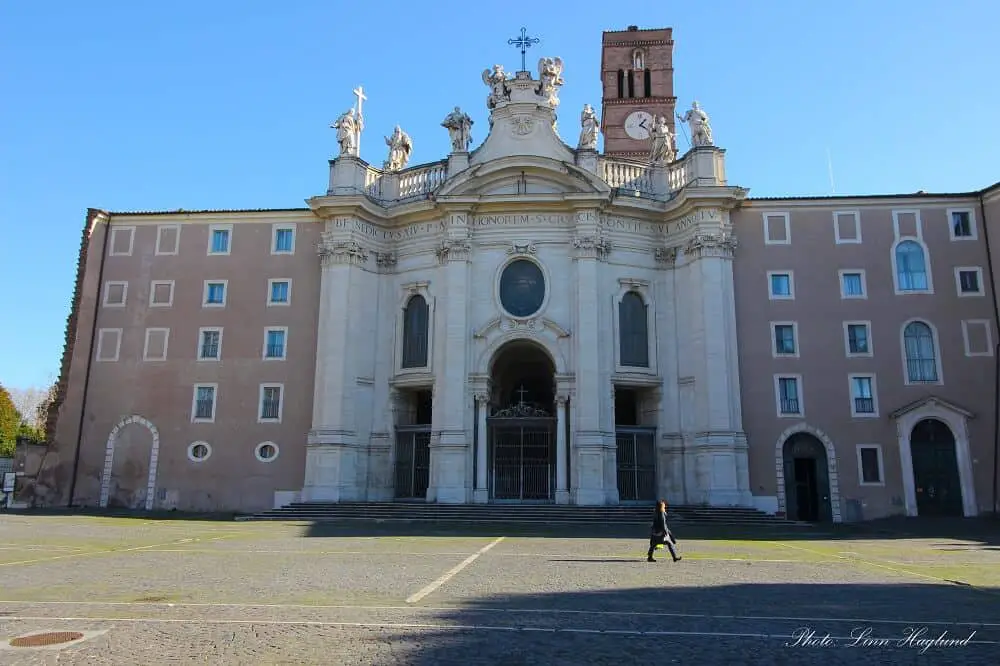
Battistero Lateranense di San Giovanni in Fonte
Looking utterly plain on the outside, the octagonal Baptistery is guaranteed to leave you in awe once you enter.
Adorned with astonishing frescos, 8 dark marble columns built up by smaller white pillars, surround the center. The floor is laid in marble too.
Look up, and an imposing gold ornated ceiling frames several more colorful frescos.
Outside mass hours, you can take a peek inside the chapel, where more gold, paintings, and statues await.
This is supposedly the world’s oldest Baptistery, dating back to the 4th century. It was built at the same time as the Basilica of Saint John Lateran but wasn’t joined until later.
This is no arguing, one of the best off the beaten path Rome attractions you can visit!
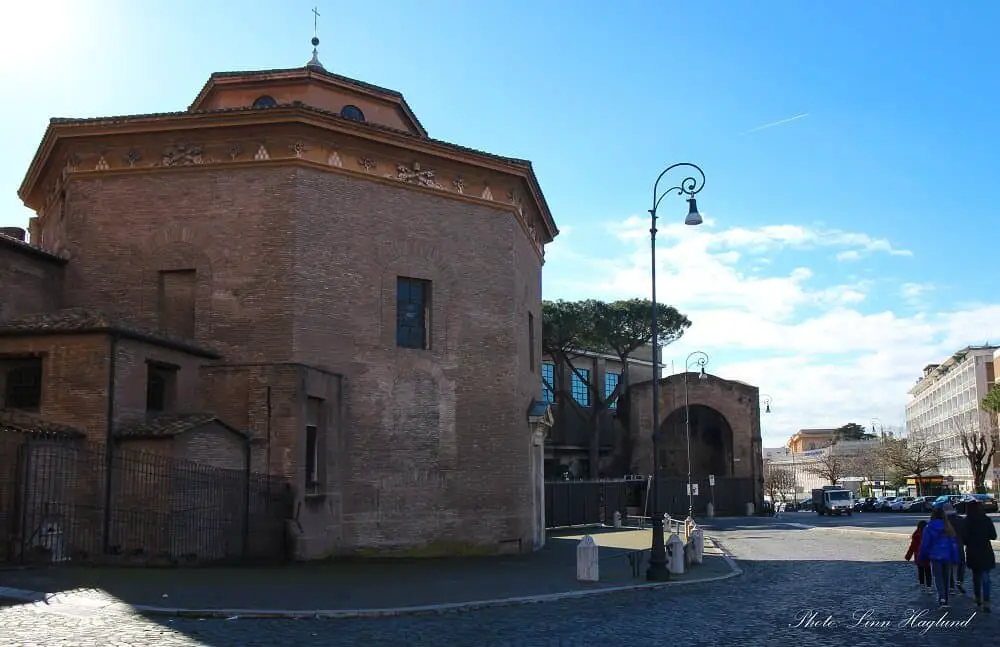
Heading to Tuscany? Make sure you read these travel tips!
- 2-day Florence itinerary
- One day in Florence
- Siena itinerary
- Things to do in Lucca
- Florence to Lucca day trip
- Things to do in San Gimignano
- Tuscany road trip itinerary
- Best towns in Tuscany
Basilica Papale di Santa Maria Maggiore
Being one of the 4 major basilicas in Rome and the largest dedicated to Saint Mary, the Basilica Papale di Santa Maria Maggiore doesn’t get far close to the attention it deserves.
Legend says that Saint Mary appeared in front of Pope Liberius and instructed him to build the church on top of a pagan temple that once stood there.
Further, it’s said that the floor design is rooted in a miraculous snowfall, thus Saint Mary of the Snow has been one of many names for the church.
The basilica is a fusion of building styles as it’s been renovated multiple times throughout the years. There are also Roman remains inside.
Don’t miss the striking statue of Pope Pius IX down the stairs at the front of the basilica.
Paying a visit to Basilica Papale di Santa Maria Maggiore is no denying one of the top things to do in Rome off the beaten track.

Baths of Caracalla
One of the top Rome hidden gems is the 3rd-century Roman ruins of the Baths of Caracalla, named after the emperor that ordered them built. Together with the Colosseum, the Baths of Caracalla was one of the biggest structures in ancient Rome.
The Baths of Caracalla had room for 2500 people and even commoners were welcome to visit the baths and use the facilities.
There were different pools of hot and cold water, massage rooms, board games, brothels, and libraries in the complex decorated with extensive mosaics and frescos.
Today, you can see large remains of floor mosaics in the baths when you walk from room to room. Even traces of what is believed to be engraved board games are found.
You can visit the baths individually and get tickets at the entrance or go on a guided tour. This guided tour of the Baths of Caracalla and the Circus Maximus is very popular.

Chiesa di Sant’ Andrea al Quirinale
Another one of Rome’s astounding churches is the Chiesa di Sant’ Andrea al Quirinale on Quirinal Hill. The front entrance is modest yet elegant and leads you into a round interior.
The gold and marble decorations making out Gian Lorenzo Bernini’s best work will have you mesmerized for sure!
There’s not much more to say about this hidden gem of Rome, you just have to see it for yourself.

Chiesa di San Carlino alle Quattro Fontane
Chiesa di San Carlino alle Quattro Fontane is an astounding off the beaten path Rome church that deserves a visit. Hidden in a corner of Via del Quirinale, a short walk from Palazzo Barberini, the church is recognized by the beautiful fountains set on the street corners.
Originally, the church was built as part of the cloister of a community of Spanish monks. The asymmetrical floor, which was a result of building the church in a small space, was later assumed by other Baroque church architects.
This is truly one of the hidden places Rome makes you mesmerized by.

Palazzo Barberini
When taking the time to get lost in Rome, secret places like the Barberini Palace’s gardens, with enchanting fountains and statues will have you spellbound.
With 1200 rooms, the palace covers an area of 12000 square meters. The founder of the majestic Barberini Palace was Maffeo Barberini, who later became Pope Urban VIII.
The Barberini family crest, the bee, can be seen throughout the property in ceilings, statues, and other decorations.
The palace houses the Galleria Nazionale d’Arte Antica where you find the most important collection of paintings, mainly from the 16th and 17th centuries, in Rome. You can also admire a great number of sculptures and frescos.
Some of the works you can expect to see are the Judith beheads Holofernes and Narcissus of Caravaggio, the Annunciation of Filippo Lippi, and La Fornaria of Rafael.
I recommend booking a guided tour of Palazzo Barberini to get an understanding of this unique site. You can book a 2 hour guided tour here to learn all the secrets about this incredible place.

MORE FROM ITALY
Reflections on the hidden gems in Rome
This is just a taste of the many wonderful things to do in Rome off the beaten path. As you can imagine, most of these attractions would be super crowded if it wasn’t for the huge competition in ancient and grand sites in Rome.
The best way to discover secret places and hidden gems in Rome is to take the time to get lost in the streets and venture away from the big sites. You’ll be surprised how many awe-inspiring places you’ll bump into.
That said, I hope these picks will give you a good start to discover the Eternal City beyond the bucket list attractions.
